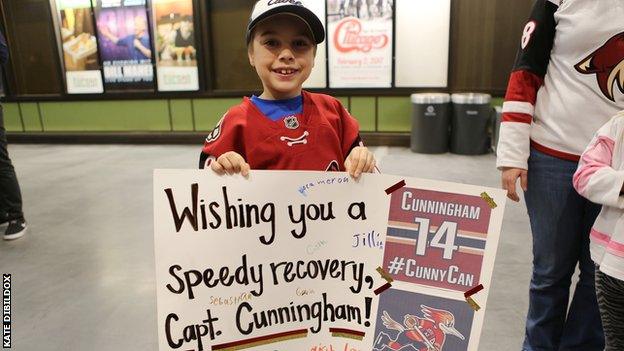Craig Cunningham: Former NHL player returns to rink after collapse and amputation
- Published
Former NHL player Craig Cunningham returns to ice after cardiac arrest
"Growing up in Canada, ice hockey is like football in England - every kid dreams of making it," says former NHL player Craig Cunningham.
"When I finally got there and everything was peachy, it all came crashing down on me just as fast as it began."
Cunningham doesn't remember anything from 19 November last year.
The 26-year-old almost died on the rink after suffering a cardiac arrest moments before his team Tucson Roadrunners' game against Manitoba in the American Hockey League.
He woke up from his coma nine days later - and then had to face the heartbreaking decision to have his left leg amputated because of infection, ending his short professional career.
Speaking to BBC World Service's Sportshour, the ex-National Hockey League player talks about his memories from that fateful night, the decision to amputate his leg, his battle to recovery and his first tentative steps back on the ice.
'90 minutes of CPR'
A fire-fighters' pipe band had just performed the national anthem inside the Tucson Convention Centre, and the puck was about to be dropped, when Tucson captain Cunningham collapsed on the ice.
Footage shows Cunningham lying on his back, his shirt and pads cut off and receiving treatment in front of his team-mates before being taken off on a stretcher as fans applaud.
He is full of praise for those rink-side fire-fighters for their role in saving his life.

Fans came out to show support for Craig Cunningham
"I don't remember any of the stuff that happened," said Cunningham, who played for Tucson's affiliated side Arizona Coyotes in the NHL.
"When the anthem ended and I lined up for the face-off, before the puck had even dropped I just collapsed. I had a sudden cardiac arrest - my heart went into ventricular fibrillation [when the heart's rhythm is disturbed and it stops working].
"Thank goodness they were still there. They rushed back on to the ice and started CPR on me. They did 90 minutes of CPR."
He received advanced life-saving therapy at hospital to support his heart and lungs.
Despite his heart not beating unaided for two days, he woke from his coma nine days after he collapsed.
'The Real Miracle on Ice' - Craig Cunningham's story
A choice - life or limb?
Cunningham seemed to have made a full recovery and even appeared in front of the media just before Christmas.
But three days later his condition deteriorated dramatically, and it turned out he had contracted an infection.
His immune system was down after nine or 10 surgeries and his calf was so swollen it had to be cut to relieve the pressure.
"They had to make a quick decision," said Cunningham. "Was my heart strong enough to fight off the infection or did they need to amputate the leg?
"I decided it was life or limb for me and I decided since I can still live with one leg, I might as well take that route."
On Christmas Eve 2016 he had his left leg amputated below the knee.
"I was just thinking about living. I haven't done a lot of things in my life that I really wanted to accomplish before my time was up. I decided I could still do that stuff with one leg - I would trade that for my leg."
Doctors still do not know what caused Cunningham's heart to go into ventricular fibrillation. He is being monitored, but the organ looks "young and healthy" and he says medics are not certain they will ever know the answer.

Craig Cunningham (centre) dropping the puck on his return to the ice
The end of a promising career
Cunningham is pretty matter of fact about a decision that ended his career so prematurely. It was a promising career that had seen him drafted into the NHL by the Boston Bruins in 2010 and play 63 NHL games for them and the Coyotes.
"I accepted it right away," he said. "I had to make decisions that I would not play again, and I decided in the hospital bed 'you're only 26, you have a lot of life to live, you can't keep focusing on why did this happen?'
"It did happen, it is lucky I pulled through and now I have to move forward and find something else."
His playing days over, Cunningham was offered a number of jobs and has accepted one as a scout at the Coyotes.
"It's a huge shock to your life," he added. "The difference when you retire is that you make the decision that your career is over.
"For me my career came to a sudden halt - I didn't have the decision to make on it. The first two or three months were tough. I looked at myself in the mirror and said 'what now?'
"This has been my whole life, everything I have focused on."

Craig Cunningham in action for the Tucson Roadrunners before the incident
Back on the ice
Four months after he collapsed, Cunningham stepped back on the ice - this time wearing a prosthetic leg.
"Mentally it was another step in my recovery," he said.
"My expectations were not high at the start. I had just started to walk when I went back on the ice - I knew it would not be awesome. But for me mentally, and my team-mates, it was important for people to see me back on the ice.
"I wanted to set an example that you may have been dealt a bad card, that this not the way you hoped life would go, that it throws you curveballs, but you have to step up and accept what comes at you, move forward and push along as well as you can."
He has a number of different feet for the different tasks required for his prosthetic leg - and says the hardest challenge is getting used to the lack of ankle control needed for skating. But Cunningham hopes he can inspire others with his resolve.
He added: "When I first had the amputation I didn't know if I would walk again, let alone skate. For me I look on social media and see these amputee athletes running and competing in the Paralympics and that pushes me along and makes me want to get out there and get better.
"Maybe people seeing me getting back on the ice, it will helps others."
"The mental side of it is sometimes the hardest part. The doctor tells me I need to slow down and take a step back and realise what is going on - it's been only a couple of months.
"I have had always had a personality that I want to push forward and push things to the limit as hard as I can. Every day I want to push my body to the limits it has now - which are different than before - pushing to try and get back to normality as much as I can."